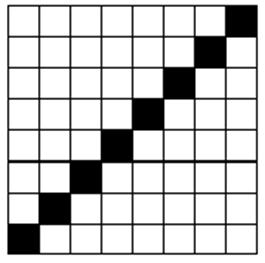当前你的浏览器版本过低,网站已在兼容模式下运行,兼容模式仅提供最小功能支持,网站样式可能显示不正常。
请尽快升级浏览器以体验网站在线编辑、在线运行等功能。
3010:N Knight
题目描述
Today, chess is one of the world's most popular games, played by millions of people worldwide at home, in clubs, online, by correspondence, and in tournaments.
Chess is played on a square board of eight rows and eight columns and denoted with letters a to h of squares. The colors of the sixty-four squares alternate and are referred to as "light squares" and "dark squares". The chessboard is placed with a light square at the right hand end of the rank nearest to each player, and the pieces are set out as shown in the diagram, with each queen on its own color.
The pieces are divided, by convention, into white and black sets. The players are referred to as "White" and "Black", and each begins the game with sixteen pieces of the specified color. These consist of one king, one queen, two rooks, two bishops, two knights and eight pawns.
Now we have another way to play with the chessboard. Give you a N*N chessboard, and ask you to place N knights on it. But the knights can’t attack each other (one knight can attack other chessman in the same row or in the column). And what’s more, no more than M knights are permissible to put on the reverse diagonal (the black grids as following picture). Now ask you how many different ways you can place this N Knight.

Chess is played on a square board of eight rows and eight columns and denoted with letters a to h of squares. The colors of the sixty-four squares alternate and are referred to as "light squares" and "dark squares". The chessboard is placed with a light square at the right hand end of the rank nearest to each player, and the pieces are set out as shown in the diagram, with each queen on its own color.
The pieces are divided, by convention, into white and black sets. The players are referred to as "White" and "Black", and each begins the game with sixteen pieces of the specified color. These consist of one king, one queen, two rooks, two bishops, two knights and eight pawns.
Now we have another way to play with the chessboard. Give you a N*N chessboard, and ask you to place N knights on it. But the knights can’t attack each other (one knight can attack other chessman in the same row or in the column). And what’s more, no more than M knights are permissible to put on the reverse diagonal (the black grids as following picture). Now ask you how many different ways you can place this N Knight.

输入解释
Input contains multiple cases each presented on a separate line. Each line contains two integer numbers N,M(1<=N<=1000,0<=M<=N).
输出解释
For each test case, your program should output the answer mod 20090818.
输入样例
1 1
输出样例
1
来自杭电HDUOJ的附加信息
| Recommend | gaojie |
最后修改于 2020-10-25T22:59:10+00:00 由爬虫自动更新
共提交 0 次
通过率 --%
| 时间上限 | 内存上限 |
| 2000/1000MS(Java/Others) | 32768/32768K(Java/Others) |
登陆或注册以提交代码